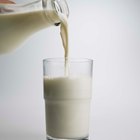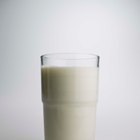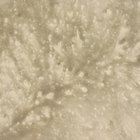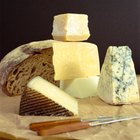
Raw milk purchased directly from the farm has the freshest flavor imaginable, but it's hard to purchase in most locations precisely because it isn't pasteurized and so poses a potential health risk. If you're a local-foods advocate or have ethical concerns about commercial dairying, that doesn't mean you have to take chances with raw milk. You can cook with it or pasteurize it yourself at home to minimize the risk.
The Raw Milk Controversy
Raw milk advocates are vocal in proclaiming its health benefits, though serious scientific scrutiny has been slow to follow. Raw milk's potential for harm is better established, which is why most jurisdictions regulate its sale. In the days before pasteurization, illnesses contracted from milk routinely caused fatal illnesses, especially in vulnerable populations such as children and the elderly. Improved dairying standards have reduced the risk of contracting diseases such as tuberculosis, but raw milk remains a dangerous vector for foodborne illness.
The Contamination Threat
Potentially dangerous bacteria such as E. coli are inescapable in a dairy, because they're contained in the milk cows' waste. The milk cows' soiled tails remain in close contact with their udders at all times, and even a moment's carelessness can introduce E. coli, Listeria monocytogenes or other pathogens into the milk. Milk's nutritive value makes it a near-perfect medium for bacterial growth, so any bacteria that do find their way into the milk reproduce enthusiastically. Even before Louis Pasteur identified this threat scientifically, dairy farmers and housewives had learned that boiling milk made it safer.
Out to Pasteur
Boiling milk kills any bacteria that are present at that time, but it also gives the milk a cooked flavor that takes away from its appeal. Fortunately, it isn't necessary to bring milk to a full boil. If you heat it to a temperature of just 145 degrees Fahrenheit, and hold it at or just above that temperature for 30 minutes, the milk will be safe to drink but loses little of its fresh flavor. Commercial milk is pasteurized through a system that holds it at a temperature of 162 F for just 15 seconds, which affects its taste only slightly more. Ultra-high temperature pasteurization exposes milk to temperatures of up to 300 F, but only for a few seconds.
Keeping it Safe
If you use raw milk in a meal such as a casserole, where it will be cooked to a final temperature of 165 F or higher, that also effectively pasteurizes it and renders it food-safe. If you need to pasteurize a portion of your raw milk for the use of children, the elderly or an expectant mother, heating the milk to 145 F is just the beginning. That kills bacteria in the milk, but doesn't protect it from re-contamination. Be sure to only handle the milk with sterilized utensils, pour it into sterilized jars, and scrub your hands scrupulously or wear gloves while you're working.
Related Articles

How Long Can Milk Stay Unrefrigerated?

Difference Between Fermented Milk & ...

Dangers of Goat Milk

How to Purchase Milk Crates

Whole Milk Vs. Lactaid Milk

Benefits of Raw Milk

Skim Milk Vs. Raw Milk

Can You Drink Milk That Expires the ...

How to Freeze Goat's Milk

Is Muscle Milk Safe for Children?

Why Does Milk Freeze in the ...

History of the Milk Bath

Why Is Milk a Good Medium for Bacterial ...

How to Cook With Lactaid

Why Does Milk Curdle When Baking a ...

Does Soaking Elk Roast in Milk Do ...

Uses for Curdled Milk

How to Cook Elbow Macaroni in Milk

Which Cheeses Contain Animal Rennet?

Can You Make Homemade Mozzarella Cheese ...
References
- On Food and Cooking: The Science and Lore of the Kitchen; Harold McGee
- Centers for Disease Control and Prevention: Raw Milk Questions and Answers
Resources
Writer Bio
Fred Decker is a trained chef and prolific freelance writer. In previous careers, he sold insurance and mutual funds, and was a longtime retailer. He was educated at Memorial University of Newfoundland and the Northern Alberta Institute of Technology. His articles have appeared on numerous home and garden sites including GoneOutdoors, TheNest and eHow.
Photo Credits
Jupiterimages/Photos.com/Getty Images